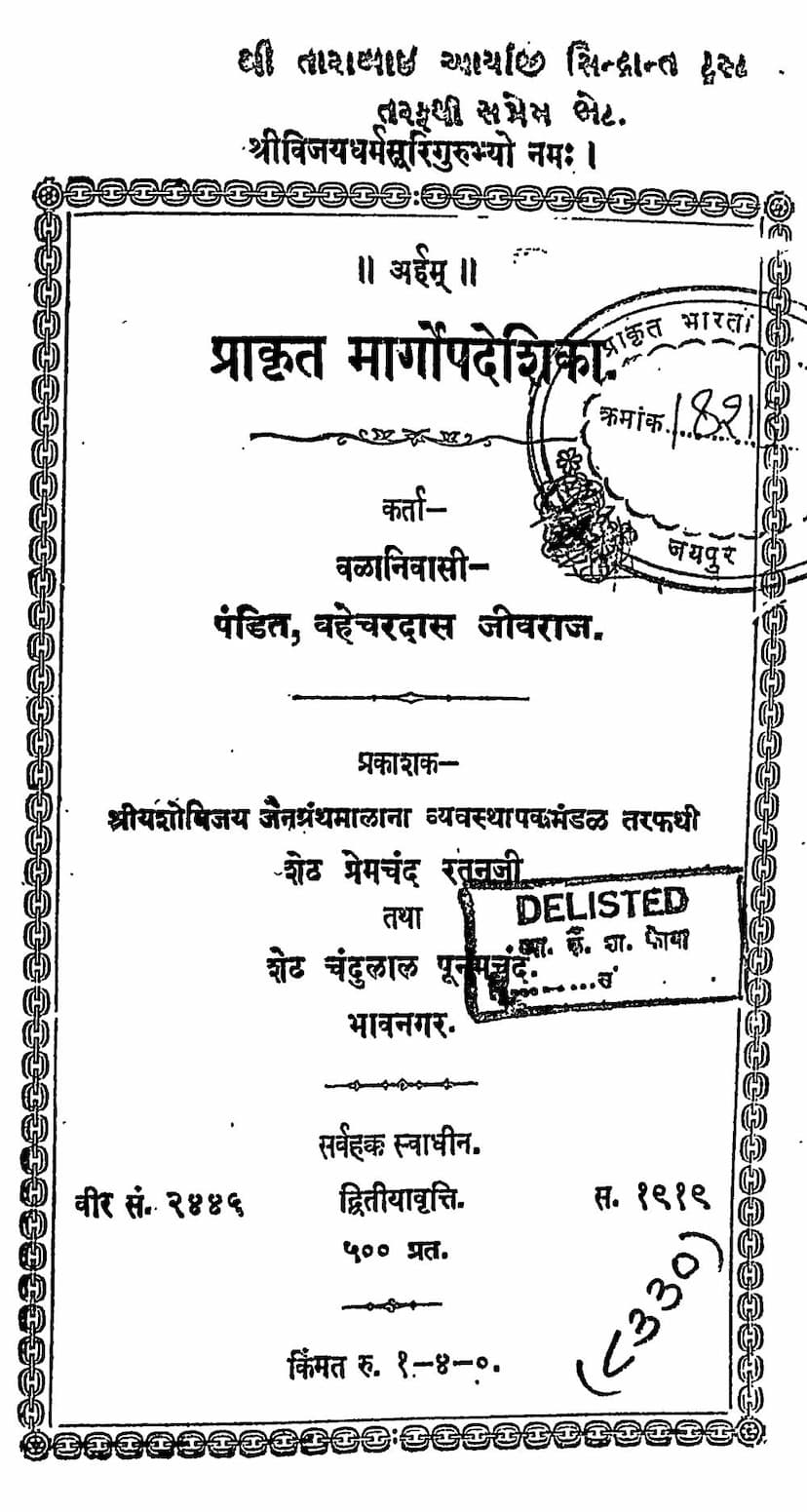Prakrit Margopdeshika
Added to library: September 2, 2025

Summary
This document is a comprehensive grammar and dictionary of the Prakrit language, written in Gujarati by Pandit Bechardas Jivraj Doshi. Titled "Prakrit Margopadeshika," it was published by Yashovijay Jain Granthmala in Bhavnagar in 1942 (VS 1999).
Here's a breakdown of its content and purpose:
Overall Purpose:
The book aims to make the study of Prakrit accessible to students, particularly those who know Gujarati. It acknowledges that while Sanskrit has many resources for learners, Prakrit lacks comprehensive and simple learning tools. The author expresses concern about the declining use of Prakrit and hopes this book will help revitalize its study.
Key Features and Content:
-
Grammar Instruction: The book systematically covers Prakrit grammar, following the principles of the renowned "Siddha Hem Vyakarana" by Acharya Hemchandrasuri.
- Alphabet and Pronunciation: It starts with the Prakrit alphabet and basic phonetic rules.
- Verb Conjugations: It details verb conjugations in the present, future, imperative, and conditional moods, covering different persons and numbers. It explains the formation of verb roots and the application of various suffixes and changes.
- Noun Declensions: The text meticulously explains the declension of nouns in all cases (prathama to saptami) and numbers (singular and plural) for masculine, feminine, and neuter genders. It covers different noun endings (akaranta, ikaranta, ukaraanta, etc.) and their variations.
- Pronouns: It covers the declension of various pronouns.
- Adverbs and Prepositions: It includes sections on useful adverbs and prefixes that modify verb meanings.
- Sandhi Rules: It explains the rules of euphonic combination in Prakrit, noting that internal sandhi is less common than external sandhi between words.
- Tenses and Moods: It covers various verb tenses and moods, including the past tense (different types), future tense, imperative, and conditional.
- Derivational Rules: It includes rules for forming Prakrit words from Sanskrit words.
- Compound Words: It discusses the formation of compound words in Prakrit.
- Special Forms: It addresses specific grammatical forms and irregularities.
-
Vocabulary (Glossary): A significant portion of the book is dedicated to a Prakrit-Gujarati glossary, defining Prakrit words and providing their grammatical usage. This is invaluable for understanding Prakrit texts.
-
Example Sentences and Dialogues: Throughout the grammar explanations, numerous example sentences and simple dialogues in Prakrit with Gujarati translations are provided to illustrate the grammatical rules and vocabulary.
-
Pedagogical Approach: The book is structured in a progressive manner, starting with basic concepts and gradually introducing more complex grammatical structures. The inclusion of questions at the end of chapters helps reinforce learning.
-
Praise and Acknowledgements: The author dedicates the book to his spiritual teachers and expresses gratitude to individuals who assisted in its preparation.
-
Editions and Printing: The preface indicates that this is the second edition, published in VS 2446 (1919 AD), with 500 copies printed. The price was ₹1-4-. The printing was done at Shri Luhanamitra Steam Printing Press in Vadodara.
Significance:
"Prakrit Margopadeshika" is a foundational text for anyone wanting to learn Prakrit, especially those from a Gujarati background. Its detailed grammar and comprehensive dictionary make it a valuable resource for students, scholars, and enthusiasts of Prakrit literature and Jain scriptures, which are often found in Prakrit. The book's commitment to simplifying the learning process makes complex linguistic concepts accessible.